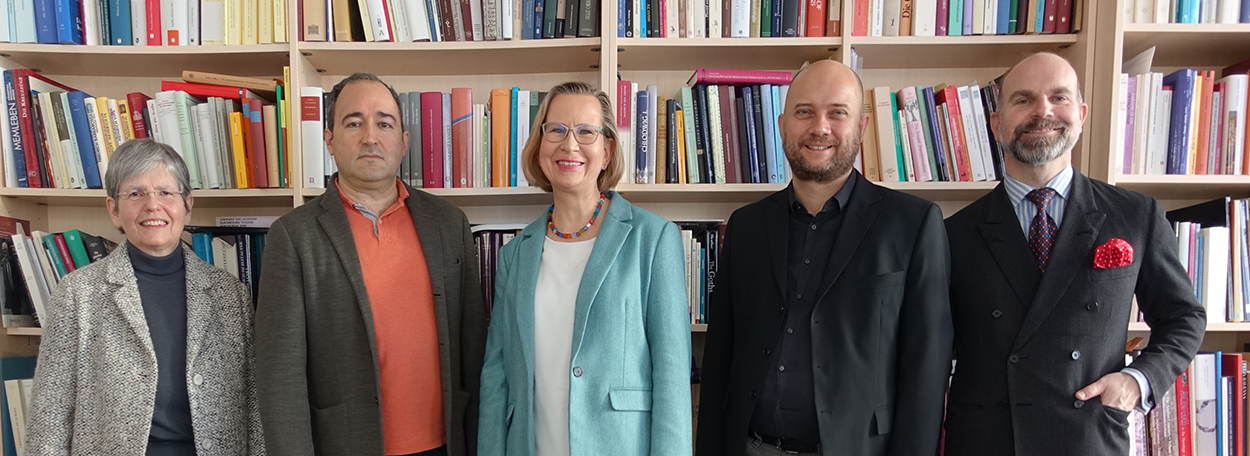
Research Strategy
The Institute for Medieval Research (IMAFO) combines two fundamental research strategies:
Firstly, a great many projects are concerned with the analysis and interpretation of the medieval heritage of Europe and Byzantium.
To this end original sources are published in print or electronic form and made accessible by means of lexica, handbooks and tables of contents. Historical-philological source-criticism, carried out increasingly using digital tools, provides the basis for dealing with thematic research questions. The second research strategy involves tackling issues current in the humanities and in cultural and social studies. Here the focus is on investigating from a global perspective the development of ethnic, political and religious identities in medieval Europe.
Why medieval research?
We are still a long way from knowing all that there is to know about the medieval period. The fragmentary sources from centuries ago will always yield only a partial picture. Yet many sources have never been investigated or have only been subject to a very limited set of questions. These include the many variant copies of medieval manuscripts, the thousands of unread late medieval charters as well as the forgotten and crumbling inscriptions from the period. These can sometimes provide new information regarding even the best-known and researched historical events. These texts and remains can teach us much about diverse aspects of human life in the past. The past can also help us to better understand the present. We still know far too little about what binds social communities together and how they transform themselves.
More...
More...
Research into the Middle Ages allows us to observe from a distance societal change and its contexts, as it unfolded over a long period of time. Our sources are extensive enough to allow fundamental developments to be observed, without being as unmanageably vast as those from more recent times. The medieval period therefore allows models and hypotheses concerning societal relations to be authenticated by reference to the sources. It is only in the reflection of the "distant mirror" of the Middle Ages that many features of the present become apparent, and the parallels are often surprising. It is the task of the historian to do justice to the complexity of past societies by representing them in a suitably nuanced way. To achieve this a wide knowledge of the source materials and a deep understanding of the circumstances of their creation is a prerequisite. Our study of the contexts of our sources' composition and transmission allows us to grasp the processes of the production and transfer of knowledge, an essential factor in societal integration.
"The Dark Ages"?
The medieval foundations of the modern world
The Middle Ages are often presented as the antithesis of the enlightened modern period: as dark centuries marked by poverty, ignorance, superstition, blood vengeance, torture and witch-hunts. Sometimes the period is glorified as one of contentment, in which each had his place in an uncomplicated society and had heroes with whom he could readily identify. Medieval fantasies from King Arthur to the Nibelungs, from the secrets of the Templars to the Lord of the Rings garner a great audience. While these conceptions of the Middle Ages are based more on prejudices than on knowledge, they demonstrate why the medieval period is so attractive: it is a time that is uncannily familiar yet at once strange. While medieval churches, castles and town quarters are ever-present in the landscape, other aspects of medieval life, the modes of warfare and economy, forms of class privilege and social organization, religious fanaticism and armed self-administered justice come across as antiquated.
More...
More...
On account of the Renaissance and humanism we feel ourselves a great deal more attached to the at least equally alien period of classical antiquity and its Greek and Latin literature.
In particular, the period of transition between antiquity and the Middle Ages is regarded as a dark one: the migration of peoples and the fall of Rome, the decline of education and the rise of ecclesiastical hegemony are seen as archaic and strange. The onset of the development of states and nations, of rational thinking and individuality, and of education and science tends to be sought in the post-medieval period, whereas the roots of the early modern witch-hunts and the suppression of deviant opinions, first perfected in the 20th century, are sought in the Middle Ages.
In the process the many elements of modern life that have their origins in the Middle Ages tend to be overlooked. Many of these relate to everyday life: buttons, glasses, forks, stirrups, pocket-watches and tower-clocks, chess, Arabic numerals, bookkeeping and banking practice, universities, paper, the printing press and gun powder were all developed in the medieval period.
The fundamental structures of modern Europe constitute a far greater research issue, however. Almost all of Europe was Christianized during late antiquity and the early medieval period. This was perhaps the hitherto most ambitious experiment in world history; it was sought to organize all areas of life according to a higher truth, the exact formulation of which remained a matter of intellectual debate throughout the Middle Ages. At the same time, the implementation of this Christian truth brought forth forms of intellectual and pragmatic resistance, which themselves belong equally to the European heritage. The new political and ethnic organization of the Continent into kingdoms named after different peoples was also shaped by Christian thought. The foundations of the modern European nation-state were laid in this manner. It took a long time for scholars to stop treating these lasting fundamental changes as the destruction of a natural order and to start examining them as historical processes. It is therefore all the more important to be judicious and true to the sources in our own depiction of the medieval world.